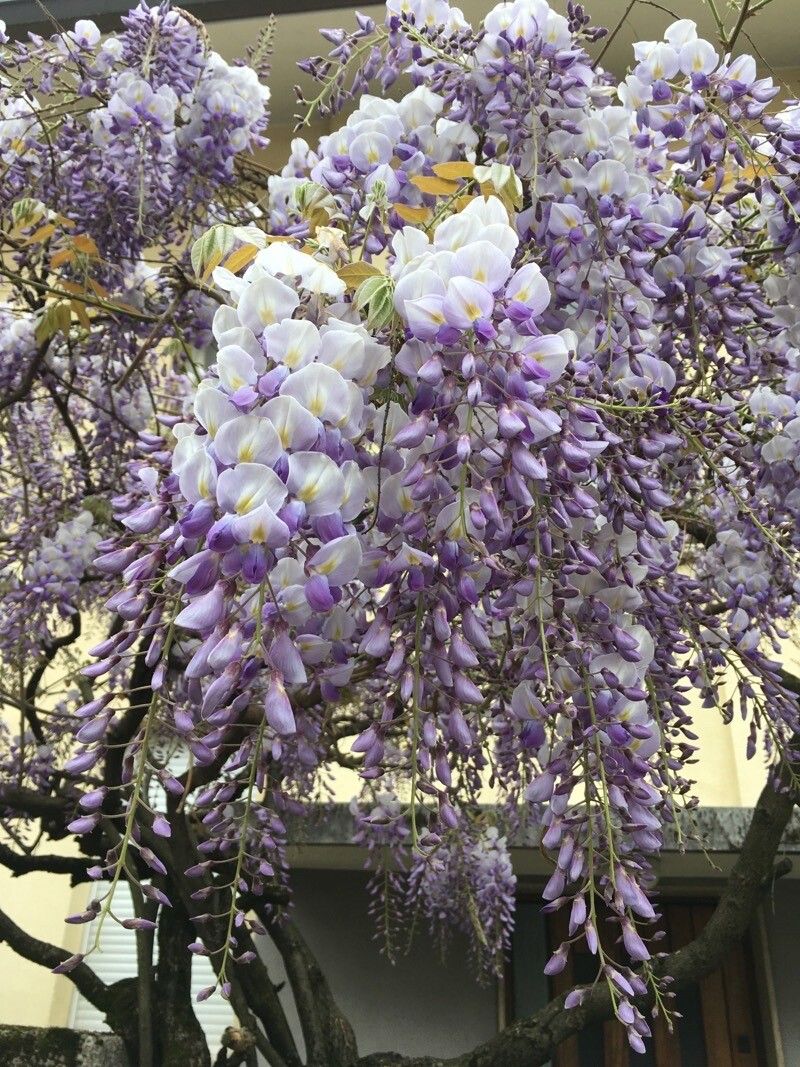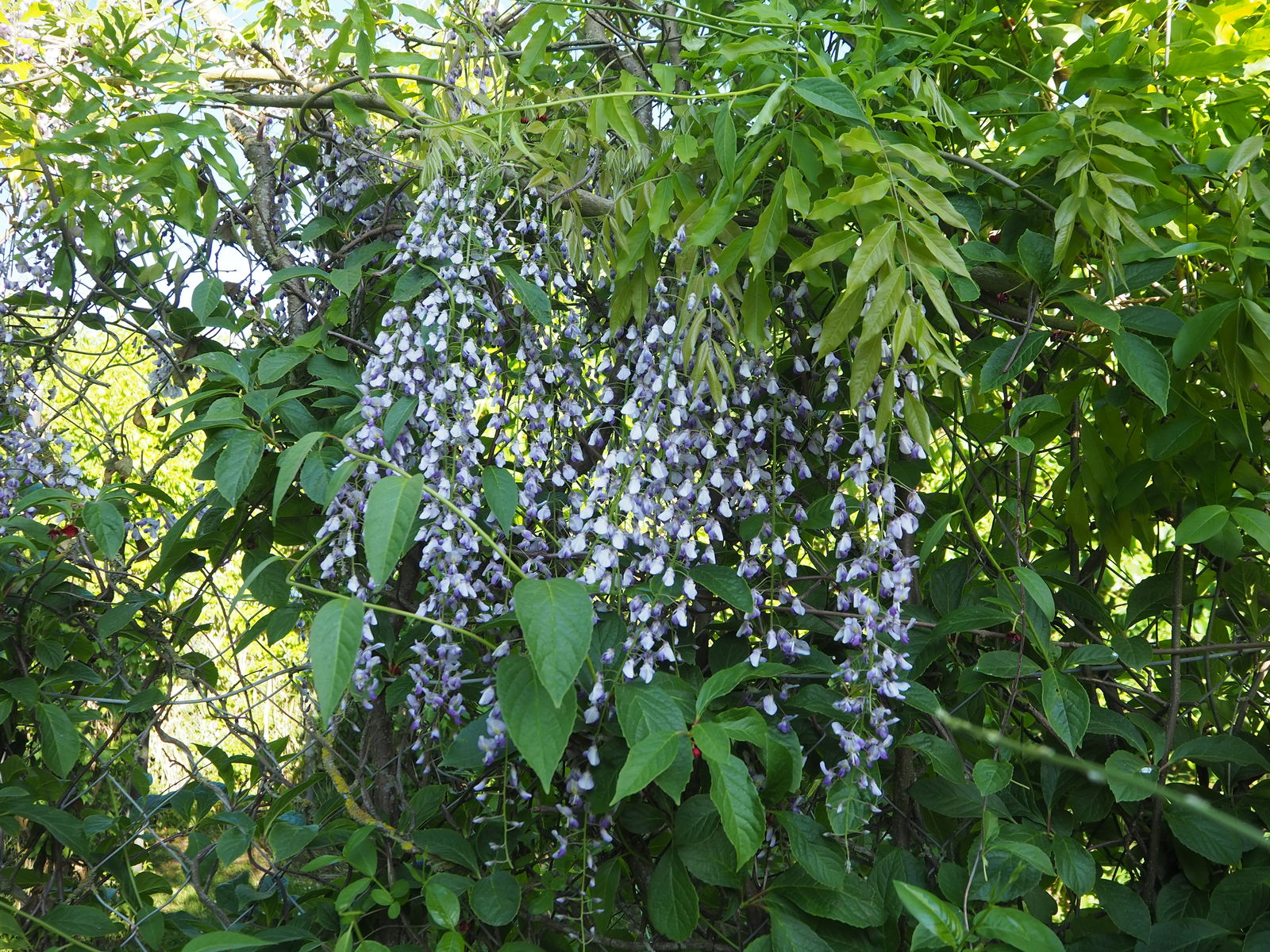Japanese Wisteria
wisteria floribunda
Also known as: ["Japanese Silk Vine","Fujimusume"]
Overview
A deciduous climbing vine known for its long, fragrant, pendulous clusters of purple-blue flowers in spring.
Benefits & Perks
["long-flowering","fragrant flowers","wildlife attractant (bees, butterflies, birds)"]
Botanical Classification
| Phylum: | Magnoliophyta |
| Class: | Magnoliopsida |
| Order: | Fabales |
| Family: | Fabaceae |
| Genus: | Wisteria |
| Botanical Name: | Wisteria floribunda |
Plant Characteristics
Basic Information
- Category: Flowers
- Suitable Location: trellis, pergola, or arbor in a sheltered location
- Suitable For:
- Is Weed: No
- Allergenicity: low
Environmental Needs
- Climate: {"temperatureRange":"–25–30°C"}
- Hardiness: {"zones":"4–9"}
- Misting: rarely required, only if ambient humidity is very low
- Drainage: Fast-draining to prevent waterlogging, but should retain some moisture.
- Soil Type: Rich, loamy soil with good organic matter content. A well-balanced cactus or rose soil mix can be used for container-grown plants.
Maintenance Level
- Maintenance Level: moderate
- Toughness Level: moderate
- Pruning Frequency: Twice a year: once in late winter (heavy pruning) and once in midsummer (light pruning to remove vigorous growth).
- Pruning Intensity: Heavy pruning in winter involves cutting back long shoots to 2–3 buds from the main stem. Summer pru
Care Details
Ideal Sunlight Coverage:
Full sun (6–8 hours of direct sunlight daily) is ideal for optimal flowering. Some afternoon shade may be beneficial in hot climates.
Sunlight Tolerance Tips:
Acclimate wisteria gradually to full sun if moved from shade. Protect from intense midday sun in hot regions to prevent leaf scorch. Outdoor placement is preferred for flowering.
Care Requirements
Care Difficulty
moderatemoderate
Sunlight
full sun to partial shade
Full sun promotes blooms; avoid deep shade; provide afternoon shade in extreme heat.
Watering
every 7–10 days during active growth, less frequently in winter
Water thoroughly but infrequently to encourage deep root growth; avoid overwatering, especially in winter; ensure good drainage to prevent waterlogging.
Soil
well-drained, fertile, slightly acidic to neutral loam
pH: Slightly acidic to neutral (pH 6.0–7.0).
Ensure good drainage; enrich with organic matter; maintain slightly acidic to neutral pH.
Temperature
Prefers temperate climates with winter chill. Ideal range is 50–75°F (10–24°C). Tolerates cold down to -10°F (-23°C) but requires warm summers for flowering.
Protect from extreme cold in early spring; ensure winter chill for flowering; avoid placing in hot, stagnant air.
Fertilizing
every 4–6 weeks during spring and summer
Fertilize sparingly to avoid excessive foliage; apply before spring growth; use a low-nitrogen formula for blooms.
Propagation
Methods
Softwood cuttings taken in early summer or hardwood cuttings in late winter. Grafting is also possible for named varieties.
Step-by-Step Propagation Guide
- Select healthy, disease-free cuttings.
- Apply rooting hormone.
- Insert into moist propagation medium.
- Maintain humidity and warmth.
- Transplant once rooted.
Best Time: Early summer for softwood cuttings; late winter for hardwood cuttings, when the plant is dormant.
Environment
High humidity (70–90%), warm temperatures (70–75°F or 21–24°C), and partial shade to encourage rooting.
Medium
Well-draining medium such as perlite and peat moss mix or cactus mix.
Hormone
Rooting hormone is recommended to improve success rates, especially for hardwood cuttings.
Timeline
Softwood cuttings may root in 4–6 weeks; hardwood cuttings take 8–12 weeks. Establishment in the garden may take an additional growing season.
Tools Needed
Pruning shears, rooting hormone, propagation tray, humidity dome, heat mat (optional), well-draining medium.
Quick Tips
Use sharp, clean tools to prevent disease; maintain consistent moisture; provide bottom heat for faster rooting.
Pruning & Repotting
Pruning Guide
Method
Cut back lateral shoots to promote flowering spurs. Remove tangled or weak growth. Train main stems along supports.
Pruning Plan
Wisteria requires heavy pruning to control growth and encourage flowering. Focus on removing excess growth and shaping the vine to support structure.
Tools
Pruning shears, loppers, saw (for thick stems), gloves, safety glasses.
Checklist
Disinfect tools; prune in late winter and summer; cut back lateral shoots; remove dead or weak growth; train main stems.
Repotting Guide
Best Season
Early spring before new growth begins is the best time to repot.
Pot Size
Increase pot size by 2–3 inches in diameter for container-grown wisteria.
Method
Remove the plant carefully, prune any circling roots, place in a slightly larger pot with fresh, well-draining soil, and water thoroughly.
Suggestions
Wisteria is typically grown in the ground or large containers. Repot container-grown plants every 2–3 years or when roots fill the pot.
Checklist
Choose a larger pot; use fresh soil mix; prune roots if necessary; water well after repotting; provide support for the vine.
Advanced Care Tips
Watering Mastery
Watering Checklist
Check soil moisture before watering; water deeply at the base; ensure drainage; adjust frequency by season.
How to Apply Water Properly
Water at the base of the plant, focusing on the root zone. Apply water slowly and deeply to saturate the soil to a depth of 6–8 inches, ensuring excess water drains away. Water in the morning to allow foliage to dry before nightfall.
Watering Schedule Tips
Water deeply once a week during spring and summer, reducing frequency in fall and winter to prevent root rot. Adjust based on rainfall and soil moisture.
Soil Improvement
Add compost or well-rotted manure to enhance fertility and structure. Incorporate perlite or sand to improve drainage if needed.
Temperature Stress Management
Signs of Temperature Issues
Chlorosis or leaf drop in extreme heat; delayed or sparse flowering in insufficient winter chill; dieback in prolonged cold without protection.
Cold Stress
Low temperatures can cause dieback of tender growth but established plants are hardy. Prolonged freezing without snow cover may damage roots.
Solution: Mulch heavily around the base in winter; protect young plants with burlap screens in extreme cold; ensure good air circulation to prevent frost pockets.
Hot Stress
Excessive heat can lead to leaf scorch, reduced flowering, and wilting, especially if combined with drought stress.
Solution: Provide afternoon shade; increase watering during heatwaves; use mulch to retain soil moisture; ensure good air circulation.
Fertilizing Guide
Fertilizing Checklist
Use balanced fertilizer; apply in early spring; avoid late-season feeding; follow package dilution rates.
Fertilizing Method
Use a balanced, slow-release fertilizer in early spring before new growth emerges. Avoid high-nitrogen fertilizers to promote flowering over foliage. Reduce or stop fertilizing in late summer to encourage dormancy.
Common Problems & Solutions
Toxicity Warning
Cats
ToxicCats are susceptible to toxicity from Wisteria floribunda, particularly from seeds and pods. The toxic compounds can cause significant gastrointestinal and neurological disturbances, leading to severe discomfort and potential systemic effects.
⚠️ Symptoms:
🌿 Toxic Parts:
⚡ Toxic If:
if eaten
Dogs
ToxicIn dogs, ingestion of Wisteria floribunda seeds and pods can lead to severe gastrointestinal upset and potential neurological effects. The toxins interfere with normal cellular processes, causing irritation and inflammation in the digestive system.
⚠️ Symptoms:
🌿 Toxic Parts:
⚡ Toxic If:
if eaten
Humans
ToxicWisteria floribunda contains lectins and other compounds that can cause gastrointestinal distress and neurological symptoms upon ingestion. The toxic effects are primarily due to the disruption of cellular functions and the irritation of the digestive tract.
⚠️ Symptoms:
🌿 Toxic Parts:
⚡ Toxic If:
if eaten
Frequently Asked Questions
Q: Is Wisteria floribunda toxic to pets?
A: Yes, all parts of the plant are toxic to dogs and cats if ingested.
Q: How do I prune Wisteria floribunda?
A: Prune in winter to control growth and encourage flowering, then again in summer to remove excess growth.
Q: Does Wisteria floribunda attract wildlife?
A: Yes, it attracts bees, butterflies, and birds due to its nectar-rich flowers.
Quick Reference
| Family: | Fabaceae |
| Care: | moderate |
| Light: | full sun to partial shade |
| Water: | every 7–10 days during activ |
Get Expert Care Tips
Download the Plantious app for personalized care reminders and plant identification!
Google Play App Store








